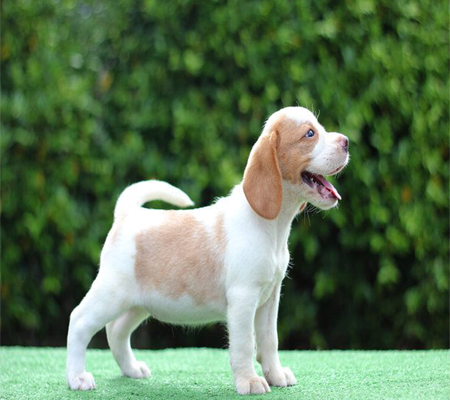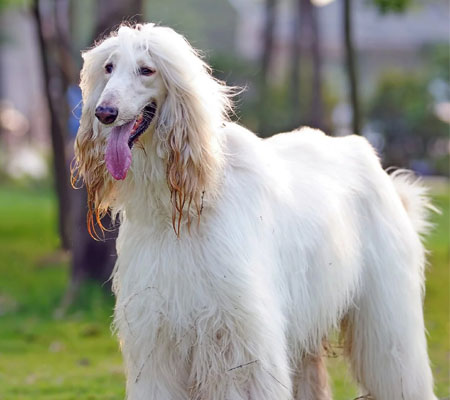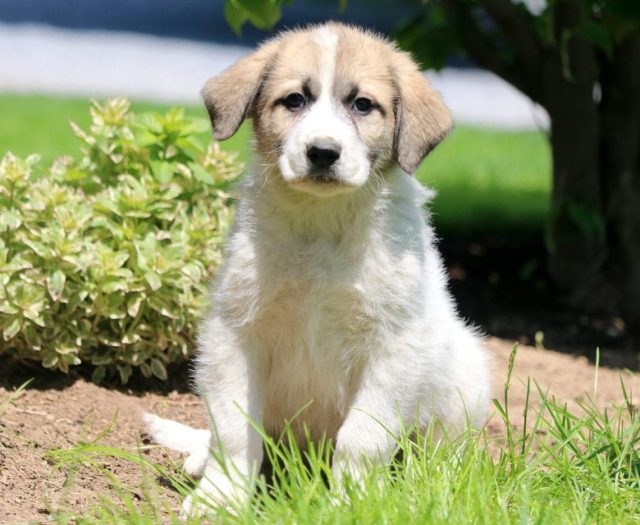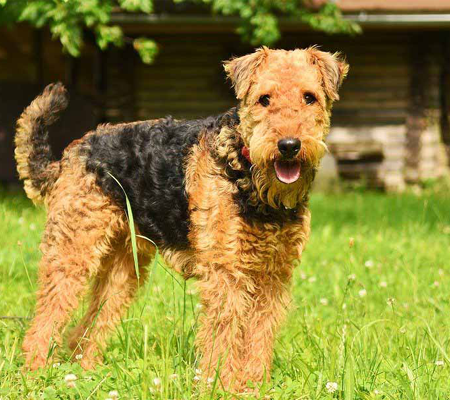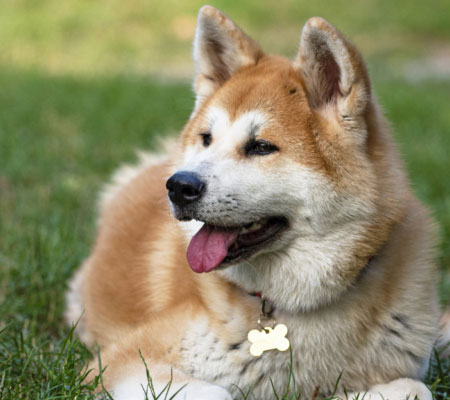Beagles are active companions for both children and
adults since they are small, compact, and durable. This dog breed is happy and
playful, but because they are hounds, they may be obstinate and require
careful, innovative training tactics.
Their noses lead them through life, and nothing
makes them happier than tracking an intriguing scent. Beagles were bred as
scenthounds to hunt small game, mostly rabbits and hare, in the past. Many
countries, including the United States, still employ them for this purpose.
However, you'll find a lot of these puppies living happily as companion dogs
and furry family members.
It's crucial to keep in mind that dogs of any breed
might have health problems at any time during their lifetimes. A decent pet
insurance plan may assist you in getting ready to provide your dog with the
care they require at any age.
| Beagle Dogs Highlights | |
|---|---|
| Breed Size | Small |
| Nature | Playful, Friendly |
| Energy Level | Active |
| Intelligence | Medium |
| Barking Level | Howler |
| Coat Length | Short |
| Breed Group | Hound |
| Droll Amount | Low |
| Good with | Familes, Children, Dog |
| Feed Level | Medium, High |
| Colour Type | Black Tan & White Beagle. Black and Tan Beagle. Chocolate Tri-Color Beagle. Blue Tri-Color Beagle. Tan and White Beagle. Lemon and White Beagles. Black Tan & Bluetick Beagle. |
| Other Facts | Easy to groom,tendency to chew,high prey drive,high potential for weight gain,apartment-friendly,cold weather tolerant,good hiking companion |
Dog History
The term "beagle" has an ambiguous origin.
It's considered to have come from the French term begueule, which means wide
neck, or the Old English word beag, which means little. Others believe it stems
from the French word beugler, which means "to yell," or the German
term begele, which means "to scold."
The breed's history is also hazy, as breeds as we
know them now did not emerge until the nineteenth century. Beagle-like dogs are
described in Greek writings dating from 400 B.C., and the Romans may have
introduced tiny rabbit-hunting hounds to England and bred them with the
indigenous hounds.
During the Norman Conquest in 1066, William the
Conqueror is said to have imported Talbot hounds (now extinct) to England. The
Beagle and Foxhound are said to have descended from these dogs.
Beagles were popular in England from the beginning
of the country's history. Extremely little beagles known as Glove Beagles were
popular during the reigns of Edward II (1307 - 1327) and Henry VII (1485 -
1509). They were small enough to be grasped in a gloved hand, according to
reports. Singing Beagles, so named because of their bugling vocals, are also
mentioned.
Pocket Beagles, which were just 9 inches tall, were
kept by Elizabeth I (1533 - 1603). Short-legged and with a pointed nose, these
little canines were represented in art. They were utilised for hunting, but
they rapidly fell out of favour due to their slowness.
When fox hunting became popular in England in the
1700s, the Beagle fell out of favour in favour of the bigger Foxhound. The
breed may have gone extinct at that time if it hadn't been for the farmers in
England, Ireland, and Wales who maintained to retain packs to hunt rabbit and
hare.
Reverend Phillip Honeywood started a Beagle pack in
Essex, England, in the mid-nineteenth century. The forebears of the
contemporary Beagle are assumed to be these dogs. Rev. Honeywood bred for
hunting ability more than appearance. A fellow Englishman, Thomas Johnson, was
in charge of raising Beagles that were both handsome and capable hunters.
American breeders began importing Beagles from
England at the same time to improve the appearance of their own dogs. Many of
the English imports were grown to be 15 to 17 inches tall at the shoulder in
order to hunt foxes. Breeders in the United States began breeding them to be
smaller so that they could be used for rabbit hunting.
Willet Randall produced the "Patch" Beagle
strain in New York around 1880, and it's worth noting. The line is mostly
white, with a huge tri-colored splotch in the middle. Because of their ability
to run quickly, they were immensely popular in the 1940s and 1950s. Lemon and
white or red and white beagles are now often referred to as "Patch"
beagles.
In 1884, the American Kennel Club and the first
Beagle speciality club were both established. In the same year, the American
Kennel Club (AKC) began registering Beagles.
Five members of the National Beagle Club bought 508 acres
of land in Western Loudoun County, Virginia, in 1916 to host field trials. The
men who bought it founded Institute Corporate to buy and own the land, then
leased it to the Institute Foundation, which maintains the property for the
National Beagle Club, which is now the location of many of the club's
operations.

Height
14-18 inch

Weight
8-14 kg

Life Span
13-15 year
Health and Care
Although not all Beagles will contract one or more
of these diseases, it's crucial to be aware of them if you're thinking about
getting one.
- Intervertebral Disk Disease
- Hip Dysplasia
- Cherry Eye
- Glaucoma
- Progressive Retinal Atrophy (PRA)
- Distichiasis
- Epilepsy
- Hypothyroidism
- Beagle Dwarfism
- Chinese Beagle Syndrome (CBS)
- Patellar Luxation
With a scenthound like a Beagle, a gated backyard is
a must. When your Beagle is outside, he should be on a leash in open places or
safely contained and monitored. Because Beagles are naturally wanderers, make
sure he's microchipped and wears identifying tags on his collar so he can be
returned to you if he gets loose.
Although some people choose to install an
underground electrical fence, this form of barrier does not keep other animals
out of your yard. Furthermore, if a smell is appealing enough, your Beagle will
be ready to risk a little jolt to follow it.
Beagles, like other dogs, benefit from obedience
training. Because Beagles will just shut down if they are handled severely,
positive reinforcement strategies are the most effective. Most Beagles are willing
to go to great lengths for a good reward.
Adolescent Beagles have a lot of energy and require
a lot of exercise to burn it off. They like going on walks with their families
or, even better, running through a field in search of rabbits (not recommended
unless you have trained your dog to come back to you). They'll like jogging
alongside you, but don't start them on a repeated activity like this until
they're 18 months or older.
When a Beagle reaches adulthood, he or she may
become rather indolent, willing to sleep around the home all day, only getting
up for meals and the occasional scratching of the ears. Don't allow this happen
because this is a breed that is prone to fat.
Dog Breed Care Tips and Important
Instructions
The beagle's short, weather-resistant coat is easy
to keep, but it comes as a cost: it sheds a lot. Brushing your beagle two to
three times a week can prevent dead hair from accumulating in your house and
encourage the growth of fresh, healthy hair. Because she has a double coat, she
will shed profusely in the spring, and you should brush her on a regular basis.
Baths are rarely required for Beagles unless they
find themselves into a sticky condition. Grooming is an excellent time to check
for coat shine (dull hair might indicate a lack of nutrients in her diet), nail
length, and ear and dental health. Her nails should be cut on a regular basis;
if they're tapping on the floor, they're too long.
Because of their long and floppy structure, beagles,
like most hounds, will require weekly ear care. This is because their long and
floppy shape might inhibit appropriate air circulation and lead to infections.
It's crucial to discuss how to inspect and clean your beagle's ears with your
veterinarian.
Using food to catch your beagle's attention during
training is a proven method to capture his focus, but be careful not to come
across as a smorgasbord. "It's simple to have a bond with the food rather
than the person," Kilcommons adds. "I anticipate a reaction once the
dog learns what's expected, and I'm not going to look like a deli. They'll do
what we want because they want it, but to get it, you have to reward them in a
way that makes it worthwhile. It is necessary for you to be passionate. Tell
him he's brilliant, smile, and look at the gauge: the tail. If it's
functioning, you'll be able to tell."
Feeding
3/4 to 1.5 cups of high-quality dry food per day,
split into two meals, is the recommended daily quantity.
NOTE: The amount of food your adult dog consumes is
determined by his size, age, build, metabolism, and degree of activity. Dogs,
like people, are unique individuals that require different amounts of food. It
practically goes without saying that a dog that is very active will require
more than a dog who is sedentary. The type of dog food you buy makes a
difference as well; the better the dog food, the more it will nourish your dog
and the less you'll have to shake into his bowl.
Beagles are notorious for stealing food. If given
the opportunity, these dogs would scavenge your pantry and garbage on a regular
basis, and they will eat until they burst. Rather than putting food available
all the time, measure his food and feed him twice a day to keep him in
excellent form. Give him the eye and hands-on tests if you're not sure if he's
overweight.
Look down at him first. There should be a waist
visible. Then, with your thumbs down his spine and fingers stretched downward,
place your hands on his back. Without pressing too much, you should be able to
feel but not see his ribs. If you can't, he'll need to eat less and exercise
more.
Also, only give out sweets in little amounts. A
bite-size training goodie will satisfy your Beagle just as much as a larger
biscuit.
Fun Facts
- Snoopy is the most renowned beagle in the world,
according to the long-running Peanuts comic strip. Spike, the Schulz family
dog, was the inspiration for Snoopy.
- The white-tipped tail of the beagle has a purpose.
The white makes it simpler to trace through the woods and long grass when
hunting—like it's a small white flag bobbing through the undergrowth!
- During his administration, Lyndon B. Johnson kept
three beagles in the White House: Him, Her, and Edgar.
- Many big-screen movies have included beagles,
including Cats & Dogs, Shiloh, and John Wick, where the whole storyline
focuses on the main character's loving beagle dog Daisy.
Home Training Tips and General Information
- This may begin as soon as your puppy arrives to your
home.
- Eight-week-old Beagle puppy
- If the puppy was reared by a tiny home breeder, he
or she may have used pee pads....
- This does not always imply that they have been
taught how to utilise them....
- The dog was most likely residing in a confined space
coated with newspaper or pads and had no choice but to urinate or excrete
there....
- As a result, if a breeder claims that the puppy is
taught at the age of eight weeks, this is at best an exaggeration.
- It will take around two months to teach your Beagle
puppy. It might take as little as a week or as long as three months in certain
circumstances. During any time that you feel stressed remember 2 things:
- It is temporary
- Your puppy does not know what to do, is trying and
with your help WILL learn
- Choose ONE location for your Beagle puppy to go to
the potty.... There should be nothing else done there.... There was no playing,
no conversing, nothing. This will demonstrate to him or her that breaching the
law is a serious matter.
- Once you've chosen an area, stand in the centre of
it and let your Beagle puppy find the perfect location to relieve himself. Try
not to talk to them....remember, this is a serious situation, and talking and
playing can wait.
- Some owners want their dog to be finished in less
than two minutes. This is a rare occurrence. If you wish, bring a chair.... You
may have to wait up to 15 minutes for your puppy to be taught. If you don't,
you could become one of the folks who writes in to say, "As soon as I
bring my Beagle inside, they pee!"
- Taking him or her outside is a good idea: Every 2
hours (may be increased to 3 hours at 3 months old, 4 hours at 4 months old,
etc. ), 15-20 minutes after each meal, each time they make a move to pee or
poo, and shortly before bedtime.
- To be effective, Beagle puppy training requires that
the puppy WANT to go outdoors. Talk with zeal and a cheerful tone (or simply
carry him if he is not listening or is too small to make it in time).
FAQS
|
Why are Beagles unsuitable as pets? |
|
Beagles, like any other breed of dog, can suffer from a variety of health
issues, including epilepsy, hypothyroidism, hip dysplasia, cherry eye, disc
disease, and more. Beagles are prone to ear infections due to their large
floppy ears, so you'll need to clean their ears on a frequent basis. |
|
Is it true that Beagles make good house dogs? |
|
Beagles are courageous, clever, and social canines who get along well
with youngsters and have a kind, tolerant, sweet, and sensitive disposition.
As long as they are well exercised and taken for long walks on a daily basis,
the breed works well inside and as an apartment dog. |
|
Is it possible to let Beagles alone at home? |
|
Adult Beagles (those above the age of 18 months) should be monitored for
no more than 4-6 hours every day. Puppy beagles should not be left alone for
more than 2 hours every day. If left alone for an extended amount of time,
beagles may acquire anxiety, become destructive (because to boredom), or bark
and bay excessively. |
|
Is it true that beagles bite? |
|
Beagles are inquisitive, intelligent, friendly, and playful canines who
rarely succumb to violence. It's also worth noting that Beagles are notorious
for biting. Biting, biting, and nipping are just a few of the most prevalent
Beagle issues, but don't panic; they're all fixable. |
|
Is it possible for beagles to swim? |
|
Beagles are great swimmers by nature, but that doesn't mean they enjoy
being in the water. Some beagles will require training in order to become
accustomed to swimming and being in or around water. If your dog is one of
these breeds, it will take them a bit longer to acclimate than if you had a
natural swimmer on your hands. |
|
Do Beagles enjoy cuddling? |
|
Do beagles enjoy cuddling? ...Beagles are excellent pets since they are
pack animals, making them friendly dogs that don't mind being stroked or held
by their human partners. It's in their nature for beagles to curl up with
other beagles and be caressed by people. |
Beagle Dogs Unique Name
| Male Name | Female Name |
|---|---|
| Blaze | Alexis |
| Chip | Amber |
| Diego | Ava |
| Hoss | Cleo |
| Iggy | Coco |
| Jackson | Destiny |
| Max | Gia |
| Mickey | Grace |
| Nelson | Heidi |
| Rambo | Honey |
| Rex | Jade |
| Riley | Raven |
| Ringo | Scarlet |
| Rocco | Shadow |
| Rockwell | Shiloh |
| Taco | Brooke |
| Tucker | Buttons |
| Tommy-boy | Chelsea |
| Wiz | Chocolate |
| Yeller | Nikita |

